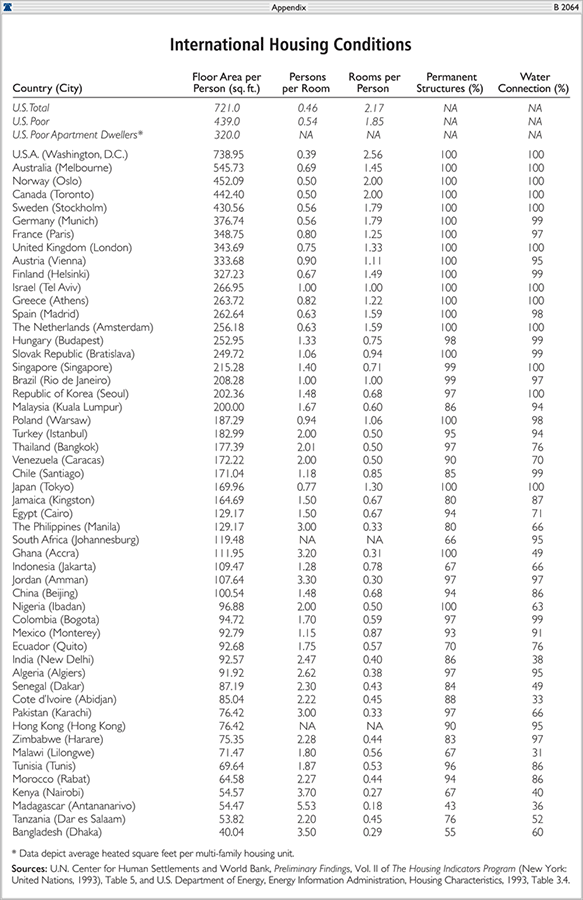Poverty is an important and emotional issue. Last year, the Census Bureau released its annual report on poverty in the United States declaring that there were 37 million poor persons living in this country in 2005, roughly the same number as in the preceding years.[4] According to the Census report, 12.6 percent of Americans were poor in 2005; this number has varied from 11.3 percent to 15.1 percent of the population over the past 20 years.[5]
To understand poverty in America, it is important to look behind these numbers-to look at the actual living conditions of the individuals the government deems to be poor. For most Americans, the word "poverty" suggests destitution: an inability to provide a family with nutritious food, clothing, and reasonable shelter. But only a small number of the 37 million persons classified as "poor" by the Census Bureau fit that description. While real material hardship certainly does occur, it is limited in scope and severity. Most of America's "poor" live in material conditions that would be judged as comfortable or well-off just a few generations ago. Today, the expenditures per person of the lowest-income one-fifth (or quintile) of households equal those of the median American household in the early 1970s, after adjusting for inflation.[6]
The following are facts about persons defined as "poor" by the Census Bureau, taken from various government reports:
- Forty-three percent of all poor households actually own their own homes. The average home owned by persons classified as poor by the Census Bureau is a three-bedroom house with one-and-a-half baths, a garage, and a porch or patio.
- Eighty percent of poor households have air conditioning. By contrast, in 1970, only 36 percent of the entire U.S. population enjoyed air conditioning.
- Only 6 percent of poor households are overcrowded. More than two-thirds have more than two rooms per person.
- The average poor American has more living space than the average individual living in Paris, London, Vienna, Athens, and other cities throughout Europe. (These comparisons are to the average citizens in foreign countries, not to those classified as poor.)
- Nearly three-quarters of poor households own a car; 31 percent own two or more cars.
- Ninety-seven percent of poor households have a color television; over half own two or more color televisions.
- Seventy-eight percent have a VCR or DVD player; 62 percent have cable or satellite TV reception.
- Eighty-nine percent own microwave ovens, more than half have a stereo, and more than a third have an automatic dishwasher.
As a group, America's poor are far from being chronically undernourished. The average consumption of protein, vitamins, and minerals is virtually the same for poor and middle-class children and, in most cases, is well above recommended norms. Poor children actually consume more meat than do higher-income children and have average protein intakes 100 percent above recommended levels. Most poor children today are, in fact, supernourished and grow up to be, on average, one inch taller and 10 pounds heavier than the GIs who stormed the beaches of Normandy in World War II.
While the poor are generally well nourished, some poor families do experience temporary food shortages. But even this condition is relatively rare; 89 percent of the poor report their families have "enough" food to eat, while only 2 percent say they "often" do not have enough to eat.
Overall, the typical American defined as poor by the government has a car, air conditioning, a refrigerator, a stove, a clothes washer and dryer, and a microwave. He has two color televisions, cable or satellite TV reception, a VCR or DVD player, and a stereo. He is able to obtain medical care. His home is in good repair and is not overcrowded. By his own report, his family is not hungry and he had sufficient funds in the past year to meet his family's essential needs. While this individual's life is not opulent, it is equally far from the popular images of dire poverty conveyed by the press, liberal activists, and politicians.
Of course, the living conditions of the average poor American should not be taken as representing all the poor. There is actually a wide range in living conditions among the poor. For example, a third of poor households have both cellular and landline telephones. A third also have telephone answering machines. At the other extreme, however, approximately one-tenth have no phone at all. Similarly, while the majority of poor households do not experience significant material problems, roughly 30 percent do experience at least one problem such as overcrowding, temporary hunger, or difficulty getting medical care.
The remaining poverty in the U.S. can be reduced further, particularly poverty among children. There are two main reasons that American children are poor: Their parents don't work much, and fathers are absent from the home.
In good economic times or bad, the typical poor family with children is supported by only 800 hours of work during a year: That amounts to 16 hours of work per week. If work in each family were raised to 2,000 hours per year-the equivalent of one adult working 40 hours per week throughout the year- nearly 75 percent of poor children would be lifted out of official poverty.
Father absence is another major cause of child poverty. Nearly two-thirds of poor children reside in single-parent homes; each year, an additional 1.5 million children are born out of wedlock. If poor mothers married the fathers of their children, almost three-quarters would immediately be lifted out of poverty.
While work and marriage are steady ladders out of poverty, the welfare system perversely remains hostile to both. Major programs such as food stamps, public housing, and Medicaid continue to reward idleness and penalize marriage. If welfare could be turned around to require work and encourage marriage, poverty among children would drop substantially.
However, while renewed welfare reform can help to reduce poverty, under current conditions, such efforts will be partially offset by the poverty-boosting impact of the nation's immigration system. Each year, the U.S. imports, through both legal and illegal immigration, hundreds of thousands of additional poor persons from abroad. As a result, one-quarter of all poor persons in the U.S. are now first-generation immigrants or the minor children of those immigrants. Roughly one in ten of the persons counted among the poor by the Census Bureau is either an illegal immigrant or the minor child of an illegal. As long as the present steady flow of poverty-prone persons from foreign countries continues, efforts to reduce the total number of poor in the U.S. will be far more difficult. A sound anti-poverty strategy must seek to increase work and marriage, reduce illegal immigration, and increase the skill level of future legal immigrants.
What Is Poverty?
For most Americans, the word "poverty" suggests destitution: an inability to provide a family with nutritious food, clothing, and reasonable shelter. For example, the "poverty Pulse" poll taken by the Catholic Campaign for Human Development in 2005 asked the general public the question: "How would you describe being poor in the U.S.?" The overwhelming majority of responses focused on homelessness, hunger or not being able to eat properly, and not being able to meet basic needs.[7]
But if poverty means lacking nutritious food, adequate warm Housing, and clothing for a family, relatively few of the 37 million people identified as being "in poverty" by the Census Bureau could be characterized as poor.[8] While material hardship does exist in the United States, it is quite restricted in scope and severity. The average "poor" person, as defined by the government, has a living standard far higher than the public imagines.
Ownership of Property and Amenities among the Poor
Chart 1 shows the ownership of property and consumer durables among poor households. The data are taken from the American Housing Survey for 2005, conducted by the U.S. Department of Housing and Urban Development and the Census Bureau, the Survey of Income and Program Participation (SIPP) conducted by the Census Bureau, and the Residential Energy Consumption Survey conducted by the U.S. Department of Energy.[9]
As the chart shows, some 43 percent of poor households own their own home. The typical home owned by the poor is a three-bedroom house with one-and-a-half baths. It has a garage or carport and a porch or patio and is located on a half-acre lot. The house was constructed in 1969 and is in good repair. The median value of homes owned by poor households was $95,276 in 2005 or 70 percent of the median value of all homes owned in the United States.[10]
Some 73 percent of poor households own a car or truck; nearly a third own two or more cars or trucks. Eighty percent have air conditioning; by contrast, in 1970, only 36 percent of the general U.S. population had air conditioning. Nearly nine in ten poor households own microwaves; more than a third have automatic dishwashers.
Poor households are well equipped with modern entertainment technology. It should come as no surprise that nearly all (97 percent) poor households have color TVs, but more than half actually own two or more color televisions. One-quarter own large-screen televisions, 78 percent have a VCR or DVD player, and almost two-thirds have cable or satellite TV reception. Some 58 percent own a stereo.
More than a third of poor households have telephone answering machines. Roughly a third have both cell phones and conventional landline telephones. More than a third have personal computers. While these numbers do not suggest lives of luxury, they are notably different from conventional images of poverty.
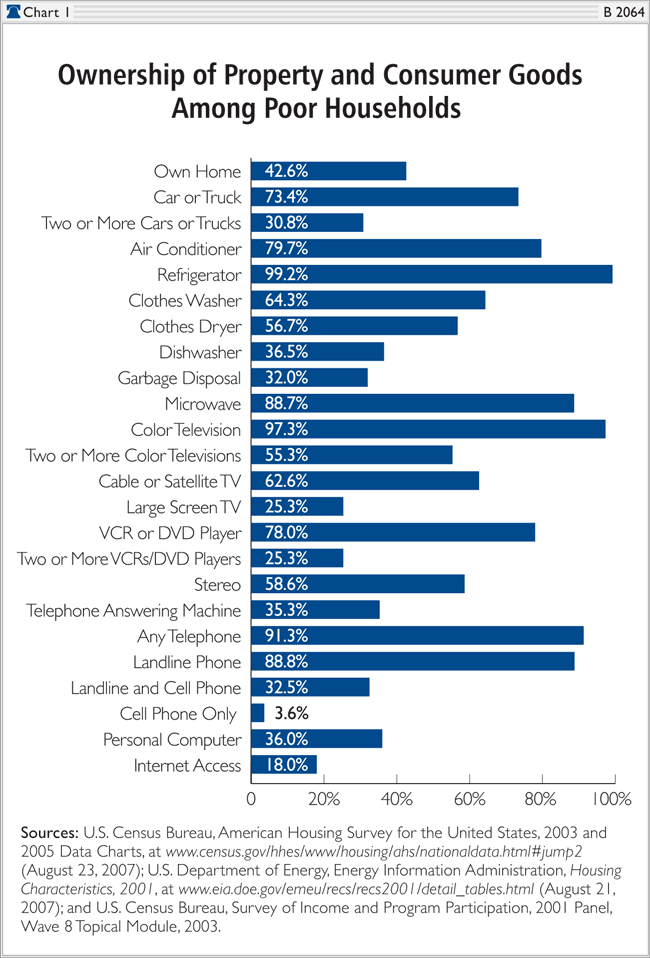
Housing Conditions
A similar disparity between popular conceptions and reality applies to the Housing conditions of the poor. Most poor Americans live in houses or apartments that are relatively spacious and in good repair. As Chart 2 shows, 49 percent of poor households live in single-family homes, either unattached single dwellings or attached units such as townhouses. Another 41 percent live in apartments, and 10 percent live in mobile homes.[11]
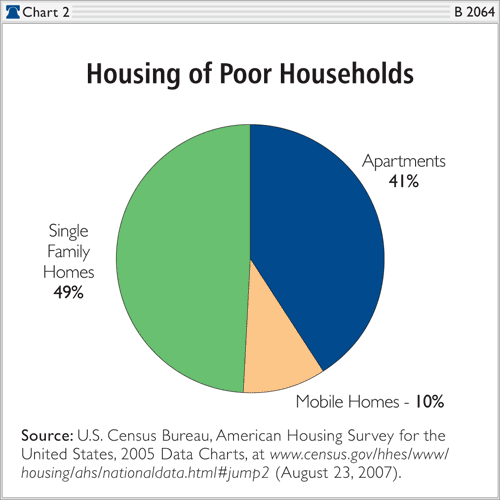
Housing Space
Both the overall U.S. population and the poor in America live, in general, in very spacious housing. As Table 1 shows, 71 percent of all U.S. households have two or more rooms per tenant. Among the poor, this figure is 66 percent.
Crowding is quite rare; only 2.4 percent of all households and 5.6 percent of poor households are crowded with more than one person per room.[12] By contrast, social reformer Jacob Riis, writing on tenement living conditions around 1890 in New York City, described crowded families living with four or five persons per room and some 20 square feet of living space per person.[13]
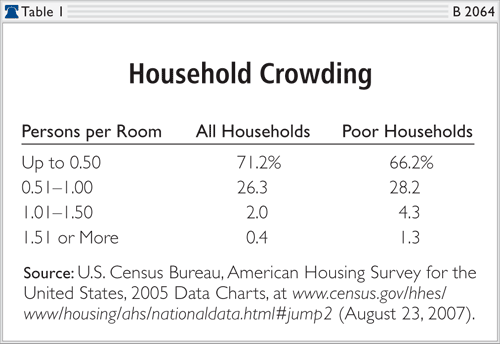
Housing space can also be measured by the number of square feet per person. The Residential Energy Consumption survey conducted by the U.S. Department of Energy shows that Americans have an average of 721 square feet of living space per person. Poor Americans have 439 square feet.[14] Reasonably comparable international square-footage data are provided by the Housing Indicator Program of the United Nations Center for Human Settlements, which surveyed Housing conditions in major cities in 54 different nations. This survey showed the United States to have, by far, the most spacious Housing units, with 50 percent to 100 percent more square footage per capita than city dwellers in other industrialized nations.[15](See Table 2.)
America's poor compare favorably with the general population of other nations in square footage of living space. The average poor American has more square footage of living space than does the average person living in London, Paris, Vienna, and Munich. Poor Americans have nearly three times the living space of average urban citizens in middle-income countries such as Mexico and Turkey. Poor American households have seven times more Housing space per person than the general urban population of very-low-income countries such as India and China. (See the appendix table for more detailed information.)
Some critics have argued that the comparisons in Table 2 are misleading.[16] These critics claim that U.S. Housing in general cannot be compared to Housing in specific European cities such as Paris or London because Housing in these cities is unusually small and does not represent the European Housing stock overall. To assess the validity of this argument, Table 3 presents national Housing data for 15 West European countries. These data represent the entire national Housing stock in each of the 15 countries. In general, the national data on Housing size are similar to the data on specific European cities presented in Table 2 and the appendix table.
As Table 3 shows, U.S. Housing (with an average size of 1,875 square feet per unit) is nearly twice as large as European Housing (with an average size of 976 square feet per unit.) After adjusting for the number of persons in each dwelling unit, Americans have an average of 721 square feet per person, compared to 396 square feet for the average European.
The Housing of poor Americans (with an average of 1,228 square feet per unit) is smaller than that of the average American but larger than that of the average European (who has 976 square feet per unit). Overall, poor Americans have an average of 439 square feet of living space per person, which is as much as or more than the average citizen in most West European countries. (This comparison is to the average European, not poor Europeans.)
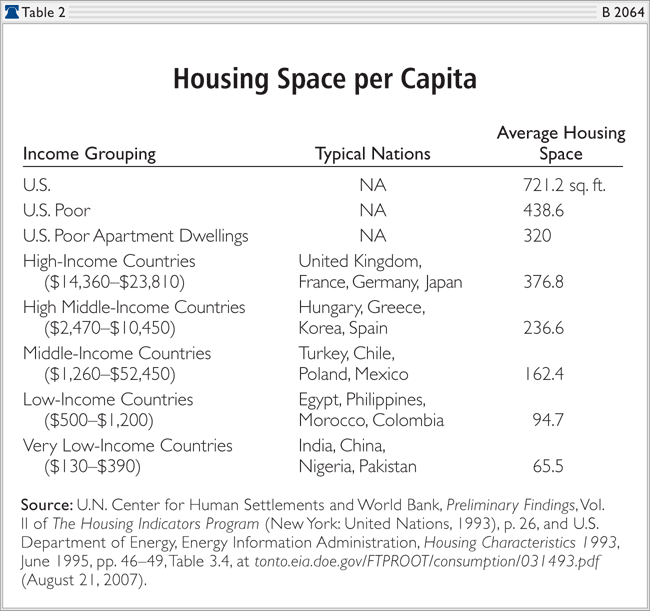
Housing Quality
Of course, it might be possible that the Housing of poor American households could be spacious but still dilapidated or unsafe. However, data from the American Housing Survey indicate that such is not the case. For example, the survey provides a tally of households with "severe physical problems." Only a tiny portion of poor households and an even smaller portion of total households fall into that category.
The most common "severe problem," according to the American Housing Survey, is a shared bathroom, which occurs when occupants lack a bathroom and must share bathroom facilities with individuals in a neighboring unit. This condition affects about 1 percent of all U.S. households and 1.6 percent of all poor households. About one percent of all households and 2.3 percent of poor households have other "severe physical problems." The most common are repeated heating breakdowns and multiple upkeep problems.
The American Housing Survey also provides a count of households affected by "moderate physical problems." A wider range of households falls into this category-9 percent of the poor and 4 percent of total households. However, the problems affecting these units are clearly modest. While living in such units might be disagreeable by modern middle-class standards, they are a far cry from Dickensian squalor. The most common problems are upkeep, lack of a full kitchen, and use of unvented oil, kerosene or gas heaters as the primary heat source. (The last condition occurs almost exclusively in the South.)
Poverty and Malnutrition
Malnutrition (also called undernutrition) is a condition of reduced health due to a chronic shortage of calories and nutriments. There is little or no evidence of poverty-induced malnutrition in the United States. It is often believed that a lack of financial resources forces poor people to eat low-quality diets that are deficient in nutriments and high in fat. However, survey data show that nutriment density (amount of vitamins, minerals, and protein per kilocalorie of food) does not vary by income class.[17] Nor do the poor consume higher-fat diets than do the middle class; the percentage of persons with high fat intake (as a share of total calories) is virtually the same for low-income and upper-middle-income persons.[18] Over-consumption of calories in general, however, is a major problem among the poor, as it is within the general U.S. population.
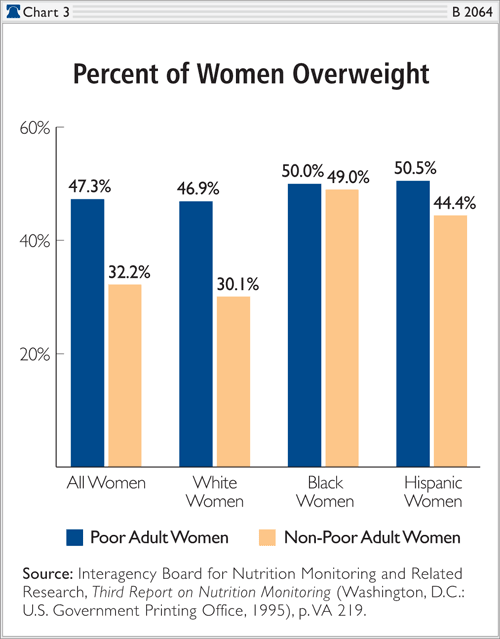
Examination of the average nutriment consumption of Americans reveals that age and gender play a far greater role than income class in determining nutritional intake. For example, the nutriment intakes of adult women in the upper middle class (with incomes above 350 percent of the poverty level) more closely resemble the intakes of poor women than they do those of upper-middle-class men, children, or teens.[19] The average nutriment consumption of upper-middle-income preschoolers, as a group, is virtually identical with that of poor preschoolers but not with the consumption of adults or older children in the upper middle class.
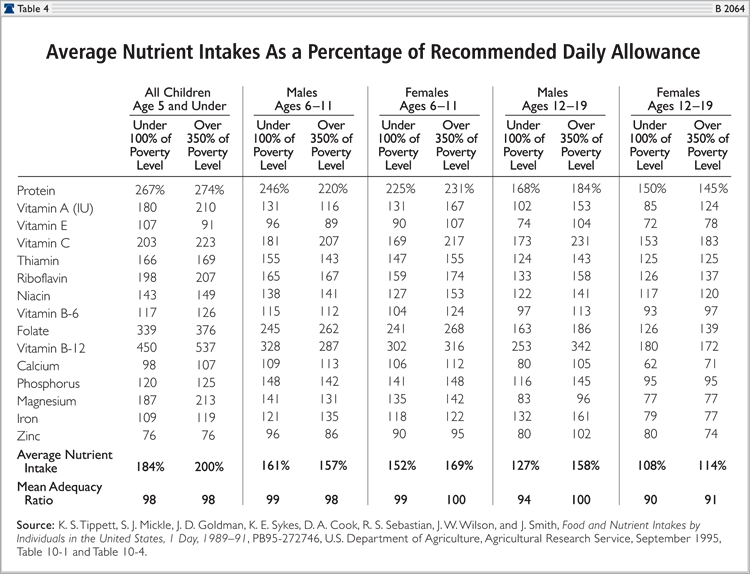
This same pattern holds for adult males, teens, and most other age and gender groups. In general, children aged 0-11 years have the highest average level of nutriment intakes relative to the recommended daily allowance (RDA), followed by adult and teen males. Adult and teen females have the lowest level of intakes. This pattern holds for all income classes.
Nutrition and Poor Children
Government surveys provide little evidence of widespread undernutrition among poor children; in fact, they show that the average nutriment consumption among the poor closely resembles that of the upper middle class. For example, children in families with incomes below the poverty level actually consume more meat than do children in families with incomes at 350 percent of the poverty level or higher (roughly $72,000 for a family of four in today's dollars).
Table 4 shows the average intake of protein, vitamins, and minerals as a percentage of the recommended daily allowance among poor and middle-class children at various age levels.[20] The intake of nutriments is very similar for poor and middle-class children and is generally well above the recommended daily level. For example, the consumption of protein (a relatively expensive nutriment) among poor children is, on average, between 150 percent and 267 percent of the RDA.
When shortfalls of specific vitamins and minerals appear (for example, among teenage girls), they tend to be very similar for the poor and the middle class. While poor teenage girls, on average, tend to under-consume vitamin E, vitamin B-6, calcium, phosphorus, magnesium, iron, and zinc, a virtually identical under-consumption of these same nutriments appears among upper-middle-class girls.
Poor Children's Weight and Stature
On average, poor children are very well nourished, and there is no evidence of widespread significant undernutrition. For example, two indicators of undernutrition among the young are "thinness" (low weight for height) and stuntedness (low height for age). These problems are rare to nonexistent among poor American children.
The generally good health of poor American children can be illustrated by international comparisons. Table 5 provides data on children's size based on the World Health Organization (WHO) Global Data Base on Child Growth: Children are judged to be short or "stunted" if their height falls below the 2.3 percentile level of standard height-to-age tables.[21] Table 5 shows the percentage of children under age five in developing nations who are judged to be "stunted" by this standard.
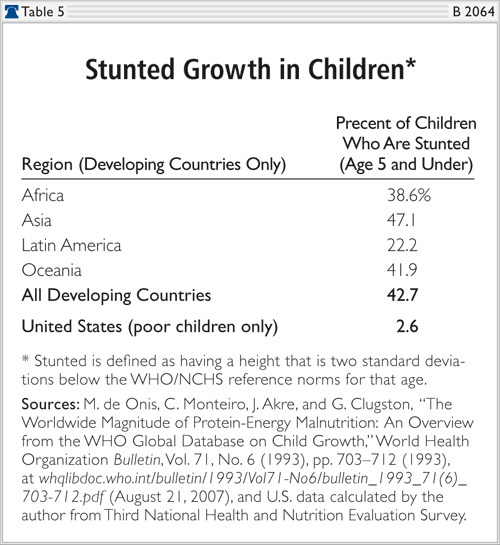
In developing nations as a whole, some 43 percent of children are stunted. In Africa, more than a third of young children are affected; in Asia, nearly half.[22]By contrast, in the United States, some 2.6 percent of young children in poor households are stunted by a comparable standard-a rate only slightly above the expected standard for healthy, well-nourished children.[23]While concern for the well-being of poor American children is always prudent, the data overall underscore how large and well-nourished poor American children are by global standards.
Throughout this century, improvements in nutrition and health have led to increases in the rate of growth and ultimate height and weight of American children. Poor children have clearly benefited from this trend. Poor boys today at ages 18 and 19 are actually taller and heavier than boys of similar age in the general U.S. population in the late 1950s. Poor boys living today are one inch taller and some 10 pounds heavier than GIs of similar age during World War II, and nearly two inches taller and 20 pounds heavier than American doughboys back in World War I.[24]
Poverty and Obesity
The principal nutrition-related health problem among the poor, as with the general U.S. population, stems from the overconsumption, not underconsumption, of food. While overweight and obesity are prevalent problems throughout the U.S. population, they are found most frequently among poor adults. Poor adult men are slightly less likely than non-poor men to be overweight (30.4 percent compared to 31.9 percent); but, as Chart 3 shows, poor adult women are significantly more likely to be overweight than are non-poor women (47.3 percent compared to 32 percent).[25]
Poverty and Consistency of Food Supply
It is clear that poor Americans are not undernourished and, over time, experience an abundance rather than a chronic shortfall of food. However, even though the poor, in general, have an ample food supply, some do suffer from temporary food shortages. For example, even if a poor household, on average, has an ample food supply, it might have to cut back meals or go without if food stamps run out at the end of the month. This problem of temporary food shortages leads some advocates to claim there is widespread "hunger" in the United States.[26]
In reality, government data show that most poor households do not suffer even from temporary food shortages. Overall, as Chart 4 shows, 98 percent of U.S. households report that they always had "enough food to eat" during the past four months, although not always the kinds of food they would have preferred. Some 1.8 percent of all households report they "sometimes" did not have enough food to eat during the previous four months, while 0.4 percent say they "often" did not have enough food.[27]

Among the poor, the figures are only slightly lower: 92.5 percent of poor households assert that they always had "enough food to eat" during the previous four months, although 26 percent of these did not always have the foods they would have preferred. Some 6 percent of poor households state that they "sometimes" did not have enough food and 1.5 percent say they "often" did not have enough food.[28] The bottom line: Although a small portion of poor households report temporary food shortages, the overwhelming majority of poor households report that they consistently have enough food to eat.
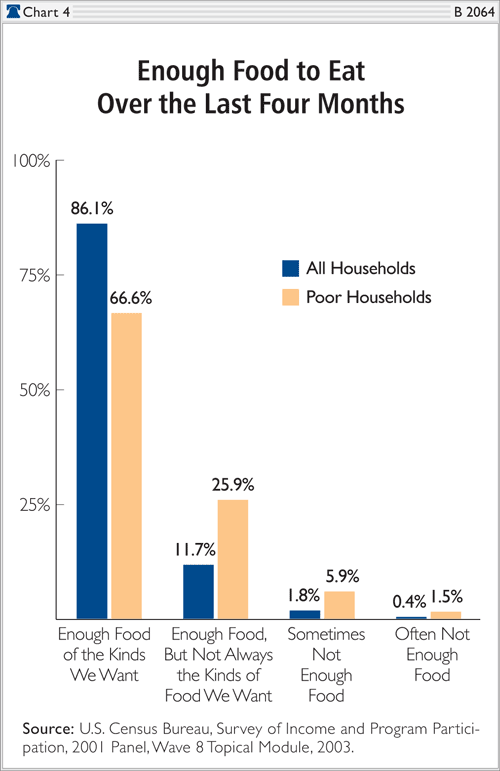
Chart 5 provides six additional questions that explore this issue in greater detail. Across this array of questions, 73 percent to 95 percent of poor households report they are free of the particular food problem mentioned. Significant food shortages affect only a minority of poor households. For example, 13 percent of poor households with children report that their children sometimes or often did not have enough food to eat during the past four months. Disturbingly, one poor adult in twenty reports going at least one entire day in the previous four months without eating at all due to a lack of money for food.[29] While this represents a stressful condition for the individual involved, it is atypical of the poor in general.
While significant temporary food shortages do occur for some households in the U.S., they are rare. For example, across the whole U.S. population, in a given month, one child in three hundred will skip a meal because of the family's lack of money for food. One child in a thousand will go a whole day without eating for the same reason.[30]
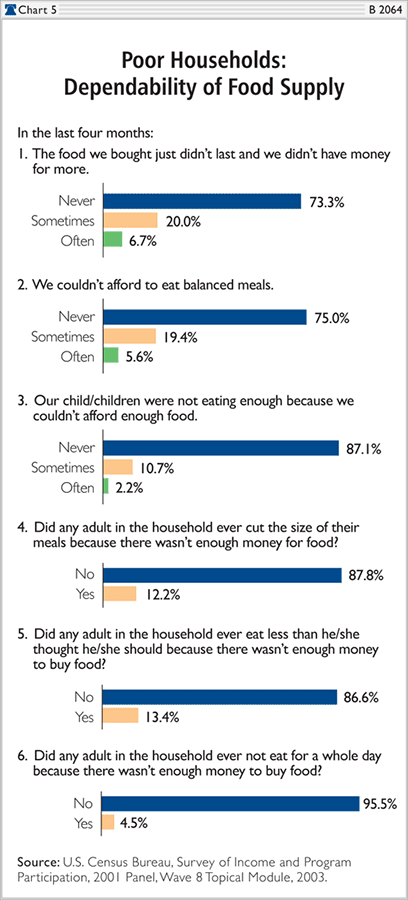
Living Conditions and Hardships among the Poor
Overall, the living standards of most poor Americans are far higher than is generally appreciated. The overwhelming majority of poor families are well housed, have adequate food, and enjoy a wide range of modern amenities, including air conditioning and cable television. Some 70 percent of poor households report that during the course of the past year they were able to meet "all essential expenses," including mortgage, rent, utility bills, and important medical care.[31] (See Chart 6.)
However, two caveats should be applied to this generally optimistic picture. First, many poor families have difficulty paying their regular bills and must scramble to make ends meet. For example, more than a third of poor families are late in paying the rent or utility bills at some point during the year.
Second, the living conditions of the average poor household should not be taken to represent all poor households. There is a wide range of living conditions among the poor: a third of poor households have both cell phones and landline phones; a third also have telephone answering machines. But, at the other extreme, a tenth of the poor have no telephone at all. Similarly, most of America's poor live in accommodations with two or more rooms per person, but around 7 percent of the poor are crowded, with less than one room per person.
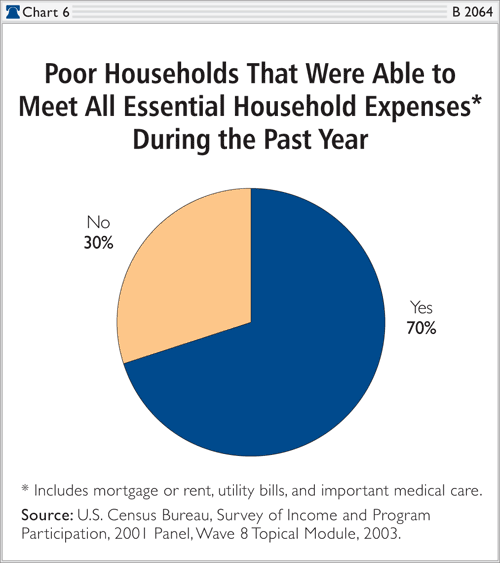
These points are illustrated in Table 6, which lists the financial and material hardships among poor households in 2003.[32] During at least one month in the preceding year, 21 percent of poor households reported they were unable to pay their fuel, gas, or electric bills promptly; around 4 percent had their utilities cut off at some point due to nonpayment. Another 14 percent of poor households failed, at some point in the year, to make their full monthly rent or mortgage payments, and 1 percent were evicted due to failure to pay rent. One in 10 poor families had their phones disconnected due to nonpayment at some time during the preceding year.
Overall, more than one-third of poor families experienced at least one financial difficulty during the year. Most had a late payment of rent or utility bills. Some 16 percent had phones or utilities cut off or were evicted.
Poor households also experienced the material problems listed on Table 6.[33] Some 13 percent had a family member who needed to go to a doctor or hospital at some point in the prior year but did not go; 7 percent reported that they did not have enough food at some point in the previous four months; and around 7 percent were overcrowded, with more than one person per room. Around 3 percent of poor households experienced upkeep problems with the physical conditions of their apartments or homes, having three or more of the physical problems listed in Table 7.
Overall Hardship
Altogether, around 62 percent of poor households experienced none of the financial or physical hardships listed in Table 6 These families were able to pay all their bills on time. They were able to obtain medical care if needed, had enough food, were not crowded, and had few upkeep problems in the home. Another 17 percent of poor households experienced one financial or material problem during the year. Around 21 percent of poor households had two or more financial or material problems.
The most common problem facing poor households was late payment of rent or utilities. While having difficulty paying monthly bills is stressful, in most cases late payment did not result in material hardship or deprivation. Relatively few of those who were late in payments subsequently had their utilities cut off or were evicted. If late payment problems are excluded from the count, we find that 71 percent of poor households had none of the remaining problems listed in Table 6. Some 18 percent had one problem, and 11 percent had two or more problems.
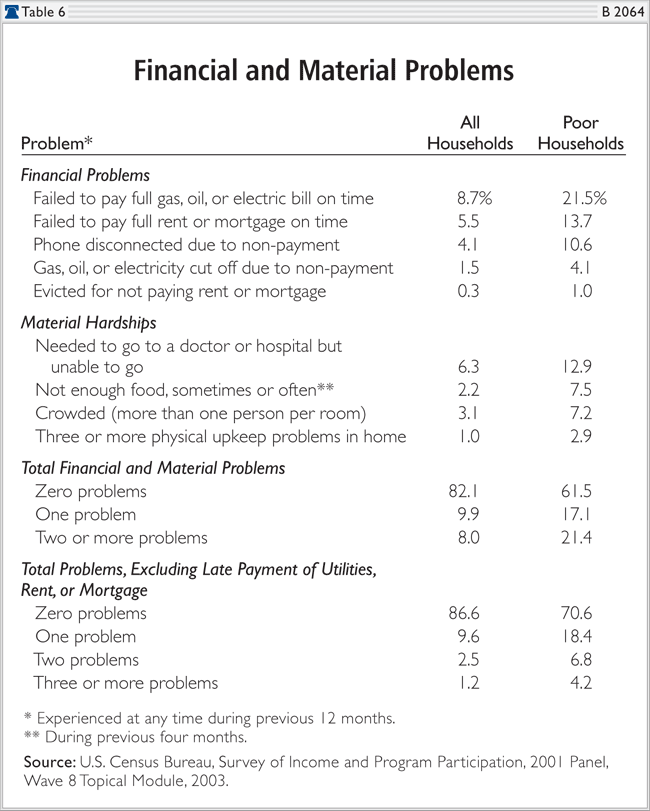
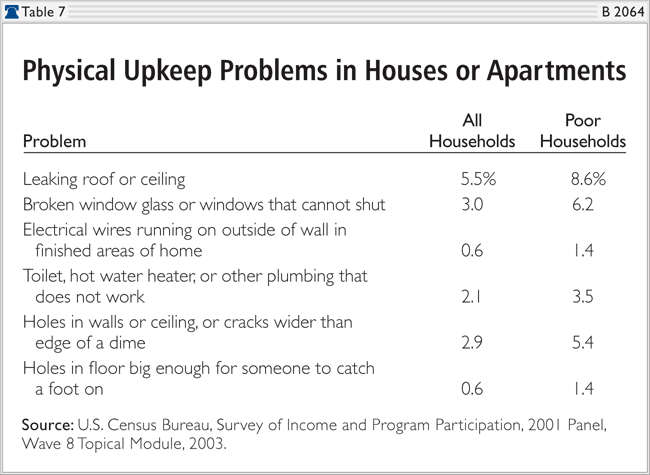
While it is appropriate to be concerned about the difficulties faced by some poor families, it is important to keep these problems in perspective. Many poor families have intermittent difficulty paying rent or utility bills but remain very well housed by historic or international standards. Even poor families, who are overcrowded by U.S. standards or face temporary food shortages, are still likely to have living conditions that are far above the world average.
Reducing Child Poverty
The generally high living standards of poor Americans are good news. Even better is the fact that our nation can substantially reduce remaining poverty, especially among children. To accomplish this, we must focus on the main causes of child poverty: low levels of parental work and high levels of single parenthood.
In good economic times or bad, the typical poor family with children is supported by only 800 hours of work during a year: That amounts to 16 hours of work per week. If work in each family were raised to 2,000 hours per year-the equivalent of one adult working 40 hours per week through the year-nearly 75 percent of poor children would be lifted out of official poverty.[34]
The decline in marriage is the second major cause of child poverty. Nearly two-thirds of poor children reside in single-parent homes; each year, an additional 1.5 million children are born out of wedlock. Increasing marriage would substantially reduce child poverty: If poor mothers married the fathers of their children, almost three-quarters would immediately be lifted out of poverty.[35]
In the late 1990s, the United States established a reasonable record in reducing child poverty. Successful anti-poverty policies were partially implemented in the welfare reform legislation of 1996, which replaced the old Aid to Families with Dependent Children (AFDC) program with a new program called Temporary Assistance to Needy Families (TANF).
A key element of this reform was a requirement that some welfare mothers either prepare for work or get jobs as a condition of receiving aid. As this requirement went into effect, welfare rolls plummeted and employment of single mothers increased in an unprecedented manner. As employment of single mothers rose, child poverty dropped rapidly. For example, in the quarter-century before welfare reform, there was no net change in the poverty rate of children in single-mother families; after reform was enacted, the poverty rate dropped in an unprecedented fashion, falling from 53.1 percent in 1995 to 39.8 percent in 2001.[36]
In general, however, welfare reform has been limited in both scope and intensity. Even in the TANF program, over half the adult beneficiaries remain idle on the rolls and are not engaged in activities leading to self-sufficiency. Work requirements are virtually nonexistent in related programs such as food stamps and public housing. Even worse, despite the fact that marriage has enormous financial and psychological benefits for parents and children, welfare reform has done little or nothing to strengthen marriage in low-income communities. Overall, the welfare system continues to encourage idle dependence rather than work and to reward single parenthood while penalizing marriage.
If child poverty is to be reduced, welfare must be transformed. Able-bodied parents must be required to work or prepare for work, and the welfare system should encourage rather than penalize marriage.
Immigration and Poverty
Unfortunately, any effort to reduce the number of poor persons in the U.S. will be partially offset by current immigration policies. Each year, immigration (both legal and illegal) adds hundreds of thousands of new persons to the nation's poverty count. Overall, first-generation immigrants and their minor children account for nearly one-fourth of all poor people in the U.S.[37]
Illegal as well as legal immigrants play a significant role in swelling the count of Americans in poverty. This may seem surprising as there is a common perception that illegal immigrants are not recorded in Census Bureau's Current Population Survey (CPS), which forms the basis of the official poverty estimate. This perception is inaccurate. The CPS and other Census surveys record whether an individual is an immigrant or non-immigrant but do not distinguish between legal and illegal immigrants. Close examination reveals that the number of self-identified immigrants appearing in the CPS exceeds the potential number of legal immigrants in the U.S. by some 10 or 11 million persons. These "extra" immigrants in the CPS are, in fact, illegal immigrants.[38] Because millions of illegal immigrants are reported in the CPS, these same illegal immigrants are also included in the official count of poor persons which is based on CPS data.
Roughly 30 percent of illegal immigrants are poor by official government standards. Among the children of illegal immigrants, the poverty rate is 37 percent.[39] Overall, illegal immigrants and their children represent between 4.5 percent and 5.0 percent of the U.S. population, but they are roughly one-tenth of all poor persons appearing in government poverty reports.[40]
Immigrants have high levels of poverty because they have low levels of education compared to non-immigrants. Roughly a third of immigrant households are headed by persons without a high school degree. Among adult illegal immigrants, some 50 percent to 60 percent lack a high school degree. By contrast, only 12 percent of non-immigrant households are headed by persons without a high school degree.[41]
Another major factor contributing to poverty among children of immigrants is out-of-wedlock childbearing. Hispanic immigrants account for around 59 percent of all births to immigrants. Among the Hispanic immigrants, 42.3 percent of children are born out of wedlock. In general, children born and raised outside marriage are seven times more likely to live in poverty than are children born and raised by married couples.[42]
As long as the current steady influx of low-skilled, poverty-prone immigrants continues, efforts to reduce the number of poor in the U.S. will be far more difficult. By contrast, policies to stop the flood of illegal immigrants into the U.S. and to increase the education and skill levels of future legal immigrants would substantially reduce the number of poor persons in the U.S. in future years.
Conclusion
The living conditions of persons defined as poor by the government bear little resemblance to notions of "poverty" promoted by politicians and political activists. If poverty is defined as lacking adequate nutritious food for one's family, a reasonably warm and dry apartment to live in, or a car with which to get to work when one is needed, then there are relatively few poor persons remaining in the United States. Real material hardship does occur, but it is limited in scope and severity.
The typical American defined as "poor" by the government has a car, air conditioning, a refrigerator, a stove, a clothes washer and dryer, and a microwave. He has two color televisions, cable or satellite TV reception, a VCR or DVD player, and a stereo. He is able to obtain medical care. His home is in good repair and is not overcrowded. By his own report, his family is not hungry and he had sufficient funds in the past year to meet his family's essential needs. While this individual's life is not opulent, it is equally far from the popular images of dire poverty conveyed by the press, liberal activists, and politicians.
But the living conditions of the average poor person should not be taken to mean that all poor Americans live without hardship. There is a wide range of living conditions among the poor. Roughly a third of poor households do face material hardships such as overcrowding, intermittent food shortages, or difficulty obtaining medical care. However, even these households would be judged to have high living standards in comparison to most other people in the world.
Moreover, the United States can readily reduce its remaining poverty, especially among children. The main causes of child poverty in the United States are low levels of parental work, high numbers of single-parent families, and low skill levels of incoming immigrants. By increasing work and marriage, reducing illegal immigration, and by improving the skill level of future legal immigrants, our nation can, over time, virtually eliminate remaining child poverty.
— Robert Rector is Senior Research Fellow in Domestic Policy Studies at The Heritage Foundation.
